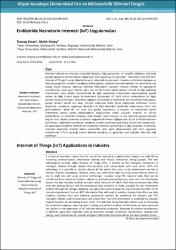Endüstride Nesnelerin Interneti (IoT) Uygulamaları
Abstract
Internet kullanımının insanlar arasındaki iletişimi, bilgi paylaşımını ve karşılıklı etkileşimi arttırarak
günlük hayatımızı önemli ölçüde değiştirdiği artık kaçınılmaz bir gerçektir. “Nesnelerin Interneti (IoT:
Internet of Things)” olarak adlandırılan yeni teknolojik kavram akıllı cihazların, birbirlerini algılayan ve
iletişime geçebilen nesneler aracılığıyla akıllı bağlantısı şeklinde tanımlanmaktadır. Bu teknoloji ile çok
sayıda, küçük boyutlu, kablosuz teknoloji kullanabilen algılayıcı (sensor) cihazlar ile yaşadığımız
çevredeki (ev, okul, işyeri, fabrika, şehir vb.) hemen hemen bütün olayları izlemek ve bilgi toplamak
mümkündür. Aynı şekilde üretim/imalat ile ilgili endüstriyel sistemlerden aktarılabilecek gerekli
verileri de Bilgi Sistemi içinde kullanabilmek Endüstriyel IoT (IIoT) olarak isimlendirilen bir diğer
kavramı ortaya çıkarmıştır. Ortamdaki algılayıcı cihazlardan ve üretimdeki veri terminallerinden gelen,
gerçek zamanlı sürekli veri akışı, internet ortamında Bulut Servis Sağlayıcılar tarafından verilen
depolama, veritabanı, uygulama hizmetleri ile Bilgi Sistemleri tarafından kullanılmaya hazır hale
getirilmektedir. Böyle bir IIoT bilgi akışı günlük yaşantımızı, iş hayatını ve endüstriyel üretim
sistemlerini olumlu yönde etkileyebilecek değişikliklere neden olacaktır. Endüstri ve IoT’nin
birleştirilmesi ile üretimde kullanılan akıllı cihazlar, insan hatasını en aza indirerek, gerçek zamanlı
bilginin karar destek sistemleri tarafından değerlendirilmesini sağlayacaktır. Bu da üretimde kalitenin
arttırılması, maliyetlerin azaltılması, rekabetçi ürünler yaratılması gibi birçok olumlu etki yaratacaktır.
Bu çalışmada Nesnelerin İnterneti’nin endüstriyel üretime uyarlanması ile ilgili çalışmalar incelenmiş,
otomatik depolama, önleyici bakım, madencilik, akıllı çevre düzenlemeleri gibi farklı uygulama
örneklerinde IoT’nin yarattığı olumlu katkılar tartışılmış ve gelişmeye açık hususlar hakkında bilgi
verilmiştir. It is now an inevitable reality that the use of the Internet has significantly changed our daily life by
increasing communication, information sharing and mutual interaction among people. The new
technological concept, called Internet of Things (IOT), is defined as the intelligent connection of
intelligent devices through objects that perceive and communicate with each other. With this
technology, it is possible to monitor almost all the events that occur in the environment we live in
(houses, schools, workplaces, factories, cities, etc.) and collect data by using sensor devices which all
are in small size and using wireless technology. Likewise, using the required data that can be
transferred from industrial systems related to production/manufacturing units into the Information
System has also revealed another concept called Industrial IoT (IIoT). Real-time continuous data flow
from the sensing devices and the production data terminals is made available for the Information
Systems through the storage, database and application services given by Cloud Service Providers in the
internet environment. Such an IIOT information flow will result in positive changes that affect our daily
activities, business lives and industrial production systems. By combining the industry and IOT,
intelligent devices used in production will ensure that real-time information is evaluated by Decision
Support Systems by minimizing human error. This will have many favorable effects such as increasing
the production capacity, reducing costs, creating competitive products. In this study, we have examined
the studies on the adaptation of IoT into the industrial production, discussed its positive contributions
in different application examples such as automatic storage, preventive maintenance, underground
mining, smart environmental systems and given additional information about the open research issues .
Source
Afyon Kocatepe Üniversitesi, Fen ve Mühendislik Bilimleri DergisiVolume
3Issue
3URI
http://fenbildergi.aku.edu.tr/wp-content/uploads/2016/12/035102-599-607.pdfhttp://hdl.handle.net/11630/4557
Collections
- Cilt 16: Sayı 3 [32]



















